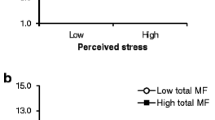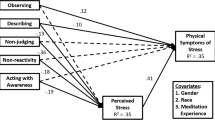Abstract
Many studies have shown that mindfulness can reduce psychological distress; however, the mechanism underlying these effects is still unknown. Along these lines, the mindfulness stress-buffering model provides a hypothesis for explaining the effect of mindfulness on health outcomes through reducing stress. In order to test this model, we investigated the mediating role of stress in the relationship between mindfulness and depression and anxiety. Four hundred and thirty-two university students completed the Mindful Attention Awareness Scale and Depression Anxiety Stress Scale. Data were analyzed by a structural equation modeling using the bootstrap resampling method (k = 10,000) using the AMOS 24.0 software. The results of the mediating model showed that stress fully mediated the relationship between mindfulness and depression and partially mediated the relationship between mindfulness and anxiety in students. Our results suggest that mindfulness, at least partially, yields beneficial effects in reducing depression and anxiety through reducing stress. Therefore, our findings supported the mindfulness stress-buffering model.

Similar content being viewed by others
References
Akaike, H. (1987). Factor analysis and AIC. Psychometrika,52(3), 317–332.
Alexopoulos, E. C., Palatsidi, V., Tigani, X., & Darviri, C. (2014). Exploring stress levels, job satisfaction, and quality of life in a sample of police officers in Greece. Safety and Health at Work,5, 210–215.
Anderson, J. C., & Gerbing, D. W. (1988). Structural equation modeling in practice: A review and recommended two-step approach. Psychological Bulletin,103, 411–423.
Bajaj, B., & Pande, N. (2016). Mediating role of resilience in the impact of mindfulness on life satisfaction and affect as indices of subjective well-being. Personality and Individual Differences,93, 63–67.
Bentler, P. M. (1990). Comparative fit indexes in structural models. Psychological Bulletin,107, 238–246.
Bishop, S. R., Lau, M., Shapiro, S., Carlson, L., Anderson, N. D., Carmody, J., et al. (2004). Mindfulness: A proposed operational definition. Clinical Psychology: Science and Practice,11, 230–241.
Bodenlos, J. S., Wells, S. Y., Noonan, M., & Mayrsohn, A. (2015). Facets of dispositional mindfulness and health among college students. The Journal of Alternative and Complementary Medicine,21, 645–652.
Bravo, A. J., Pearson, M. R., & Kelley, M. L. (2018). Mindfulness and psychological health outcomes: A latent profile analysis among military personnel and college students. Mindfulness,9, 258–270.
Brown, K. W., & Ryan, R. M. (2003). The benefits of being present: Mindfulness and its role in psychological well-being. Journal of Personality and Social Psychology,84, 822–848.
Browne, M. W., & Cudeck, R. (1993). Alternative ways of assessing model fit. In K. A. Bollen & J. S. Long (Eds.), Testing structural equation models (pp. 136–159). Newbury Park: Sage.
Carlson, L. E., Speca, M., Patel, K. D., & Goodey, E. (2004). Mindfulness-based stress reduction in relation to quality of life, mood, symptoms of stress and levels of cortisol, dehydroepiandrosterone sulfate (DHEAS) and melatonin in breast and prostate cancer outpatients. Psychoneuroendocrinology,29, 448–474.
Coffey, K. A., & Hartman, M. (2008). Mechanisms of action in the inverse relationship between mindfulness and psychological distress. Complementary Health Practice Review,13, 79–91.
Creswell, J. D. (2015). Biological pathways linking mindfulness with health. In K. W. Brown, J. D. Creswell, & R. M. Ryan (Eds.), Handbook of mindfulness: Theory, research, and practice. New York: Guilford Publications.
Davis, T. J., Morris, M., & Drake, M. M. (2016). The moderation effect of mindfulness on the relationship between adult attachment and wellbeing. Personality and Individual Differences,96, 115–121.
de Frias, C. M., & Whyne, E. (2015). Stress on health-related quality of life in older adults: The protective nature of mindfulness. Aging & Mental Health,19, 201–206.
Desrosiers, A., Vine, V., Klemanski, D. H., & Nolen-Hoeksema, S. (2013). Mindfulness and emotion regulation in depression and anxiety: Common and distinct mechanisms of action. Depression and Anxiety,30, 654–661.
Edman, J. S., Greeson, J. M., Roberts, R. S., Kaufman, A. B., Abrams, D. I., Dolor, R. J., et al. (2017). Perceived stress in patients with common gastrointestinal disorders: Associations with quality of life, symptoms and disease management. Explore: The Journal of Science and Healing,13, 124–128.
Garland, E., Gaylord, S., & Park, J. (2009). The role of mindfulness in positive reappraisal. Explore: The Journal of Science and Healing,5, 37–44.
Ghorbani, N., Watson, P. J., & Weathington, B. L. (2009). Mindfulness in Iran and the United States: Cross-cultural structural complexity and parallel relationships with psychological adjustment. Current Psychology,28, 211–224.
Hashemi, R., Moustafa, A. A., Rahmati Kankat, L., & Valikhani, A. (2017). Mindfulness and suicide ideation in Iranian cardiovascular patients: testing the mediating role of patience. Psychological Reports. https://doi.org/10.1177/0033294117746990.
Hawkins, W. E., Hawkins, M. J., & Seeley, J. (1992). Stress, health-related behavior and quality of life on depressive symptomatology in a sample of adolescents. Psychological Reports,71, 183–186.
Hoge, E. A., Bui, E., Palitz, S. A., Schwarz, N. R., Owens, M. E., Johnston, J. M., et al. (2017). The effect of mindfulness meditation training on biological acute stress responses in generalized anxiety disorder. Psychiatry Research,262, 328–332.
Hu, L., & Bentler, P. M. (1995). Evaluating model fit. In R. H. Hoyle (Ed.), Structural equation modeling, concepts, issues, and applications (pp. 76–99). Thousand Oaks: Sage.
Jacobs, I., Wollny, A., Sim, C. W., & Horsch, A. (2016). Mindfulness facets, trait emotional intelligence, emotional distress, and multiple health behaviors: A serial two-mediator model. Scandinavian Journal of Psychology,57, 207–214.
Kieszkowska-Grudny, A. (2016). Mindfulness in the treatment of chronic pain and improvement in the quality of life of both oncological and non-oncological patients. OncoReview,6, 77–85.
Kraemer, K. M., O’Bryan, E. M., & McLeish, A. C. (2016). Intolerance of uncertainty as a mediator of the relationship between mindfulness and health anxiety. Mindfulness,7, 859–865.
Liu, Y., Li, T., Guo, L., Zhang, R., Feng, X., & Liu, K. (2017). The mediating role of sleep quality on the relationship between perceived stress and depression among the elderly in urban communities: A cross-sectional study. Public Health,149, 21–27.
Loo, J. M., Tsai, J. S., Raylu, N., & Oei, T. P. (2014). Gratitude, hope, mindfulness and personal-growth initiative: Buffers or risk factors for problem gambling? PLoS ONE,9, e83889.
Lovibond, S. H., & Lovibond, P. F. (1995). Manual for the depression anxiety stress scale. Sydney: The Psychology Foundation of Australia Inc.
MacKinnon, D. P., Lockwood, C. M., & Williams, J. (2004). Confidence limits for the indirect effect: Distribution of the product and resampling methods. Multivariate Behavioral Research,39, 99–128.
Mandal, S. P., Arya, Y. K., & Pandey, R. (2011). Mindfulness, emotion regulation and subjective wellbeing: An overview of pathways to positive mental health. Indian Journal of Social Science Research,8, 159–167.
Murphy, M. J., Mermelstein, L. C., Edwards, K. M., & Gidycz, C. A. (2012). The benefits of dispositional mindfulness in physical health: A longitudinal study of female college students. Journal of American College Health,60, 341–348.
O’Leary, K., & Dockray, S. (2015). The effects of two novel gratitude and mindfulness interventions on well-being. The Journal of Alternative and Complementary Medicine,21, 243–245.
Palmer, A., & Rodger, S. (2009). Mindfulness, stress, and coping among university students. Canadian Journal of Counseling,43, 198–212.
Pepping, C. A., O’donovan, A., Zimmer-Gembeck, M. J., & Hanisch, M. (2014). Is emotion regulation the process underlying the relationship between low mindfulness and psychosocial distress? Australian Journal of Psychology,66, 130–138.
Ray, T. K., Tat’Yana, A. K., & Pana-Cryan, R. (2017). Employment arrangement, job stress, and health-related quality of life. Safety Science,100, 46–56.
Roberts, K. C., & Danoff-Burg, S. (2010). Mindfulness and health behaviors: Is paying attention good for you? Journal of American College Health,59, 165–173.
Sahebi, A., Asghari, M. J., & Salari, R. S. (2008). Validation of depression anxiety and stress scale for an Iranian population. Developmental Psychology,1, 299–312.
Seib, C., Whiteside, E., Lee, K., Humphreys, J., Tran, T. H. D., Chopin, L., et al. (2014). Stress, lifestyle, and quality of life in midlife and older Australian women: Results from the stress and the health of women study. Women’s Health Issues,24, 43–52.
Smith, G. D., & Yang, F. (2017). Stress, resilience and psychological well-being in Chinese undergraduate nursing students. Nurse Education Today,49, 90–95.
Valikhani, A., Abbasi, Z., Radman, E., Goodarzi, M. A., & Moustafa, A. A. (2018). Insecure attachment and subclinical depression, anxiety, and stress: A three-dimensional model of personality self-regulation as a mediator. The Journal of Psychology, 152(8), 548–572.
Valikhani, A., & Goodarzi, M. A. (2017). Contingencies of self-worth and psychological distress in Iranian patients seeking cosmetic surgery: Integrative self-knowledge as mediator. Aesthetic Plastic Surgery, 41(4), 955–963.
Valikhani, A., Goodarzi, M. A., & Hashemi, R. (2019). Psychometric properties of dispositional self-regulation scale in Iranian population and predicting inhibitory/initiatory self-control on the basis of it. Current Psychology, 38(1), 154–164.
Webb, J. R., Phillips, T. D., Bumgarner, D., & Conway-Williams, E. (2013). Forgiveness, mindfulness, and health. Mindfulness,4, 235–245.
Weinstein, N., Brown, K. W., & Ryan, R. M. (2009). A multi-method examination of the effects of mindfulness on stress attribution, coping, and emotional well-being. Journal of Research in Personality,43, 374–385.
Wheaton, B., Muthen, B., Alwin, D. F., & Summers, G. (1977). Assessing reliability and stability in panel models. Sociological Methodology,8, 84–136.
Yang, X., Ge, C., Hu, B., Chi, T., & Wang, L. (2009). Relationship between quality of life and occupational stress among teachers. Public Health,123, 750–755.
Zhang, R., Yin, J., & Zhou, Y. (2017). Effects of mindfulness-based psychological care on mood and sleep of leukemia patients in chemotherapy. International Journal of Nursing Sciences,4, 357–361.
Author information
Authors and Affiliations
Corresponding author
Ethics declarations
Conflict of interest
The authors declare that they have no conflict of interest.
Informed Consent
Informed consent was obtained from all individual participants included in the study.
Additional information
Publisher's Note
Springer Nature remains neutral with regard to jurisdictional claims in published maps and institutional affiliations.
Electronic supplementary material
Below is the link to the electronic supplementary material.
Rights and permissions
About this article
Cite this article
Valikhani, A., Rahmati Kankat, L., Hariri, P. et al. Examining the Mediating Role of Stress in the Relationship Between Mindfulness and Depression and Anxiety: Testing the Mindfulness Stress-Buffering Model. J Rat-Emo Cognitive-Behav Ther 38, 14–25 (2020). https://doi.org/10.1007/s10942-019-00321-7
Published:
Issue Date:
DOI: https://doi.org/10.1007/s10942-019-00321-7




